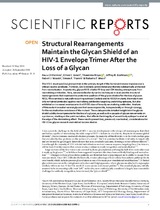| dc.contributor.author | Ferreira, Roux-Cil | |
| dc.contributor.author | Grant, Oliver C. | |
| dc.contributor.author | Moyo, Thandeka | |
| dc.contributor.author | Dorfman, Jeffrey R. | |
| dc.contributor.author | Woods, Robert J. | |
| dc.contributor.author | Travers, Simon A. | |
| dc.contributor.author | Wood, Natasha T. | |
| dc.date.accessioned | 2018-10-15T07:41:52Z | |
| dc.date.available | 2018-10-15T07:41:52Z | |
| dc.date.issued | 2018 | |
| dc.identifier.citation | Ferreira, R-C. (2018). Structural rearrangements maintain the Glycan Shield of an HIV-1 envelope trimer after the loss of a glycan. Scientific Reports, 8: 15031 | en_US |
| dc.identifier.issn | 2045-2322 | |
| dc.identifier.uri | http://dx.doiorg/10.1038/s41598-018-33390-2 | |
| dc.identifier.uri | http://hdl.handle.net/10566/4117 | |
| dc.description.abstract | The HIV-1 envelope (Env) glycoprotein is the primary target of the humoral immune response and a
critical vaccine candidate. However, Env is densely glycosylated and thereby substantially protected
from neutralisation. Importantly, glycan N301 shields V3 loop and CD4 binding site epitopes from
neutralising antibodies. Here, we use molecular dynamics techniques to evaluate the structural
rearrangements that maintain the protective qualities of the glycan shield after the loss of glycan
N301. We examined a naturally occurring subtype C isolate and its N301A mutant; the mutant not
only remained protected against neutralising antibodies targeting underlying epitopes, but also
exhibited an increased resistance to the VRC01 class of broadly neutralising antibodies. Analysis
of this mutant revealed several glycans that were responsible, independently or through synergy,
for the neutralisation resistance of the mutant. These data provide detailed insight into the glycan
shield’s ability to compensate for the loss of a glycan, as well as the cascade of glycan movements on
a protomer, starting at the point mutation, that affects the integrity of an antibody epitope located at
the edge of the diminishing effect. These results present key, previously overlooked, considerations for
HIV-1 Env glycan research and related vaccine studies. | en_US |
| dc.language.iso | en | en_US |
| dc.publisher | Nature Research | en_US |
| dc.rights | Open Access This article is licensed under a Creative Commons Attribution 4.0 International
License, which permits use, sharing, adaptation, distribution and reproduction in any medium or
format, as long as you give appropriate credit to the original author(s) and the source, provide a link to the Creative
Commons license, and indicate if changes were made. The images or other third party material in this
article are included in the article’s Creative Commons license, unless indicated otherwise in a credit line to the
material. If material is not included in the article’s Creative Commons license and your intended use is not permitted
by statutory regulation or exceeds the permitted use, you will need to obtain permission directly from the
copyright holder. To view a copy of this license, visit http://creativecommons.org/licenses/by/4.0/.
© The Author(s) 2018 | |
| dc.subject | HIV-1 | en_US |
| dc.subject | Humoral immune response | en_US |
| dc.subject | Glycan shield | en_US |
| dc.title | Structural rearrangements maintain the Glycan Shield of an HIV-1 envelope trimer after the loss of a glycan | en_US |
| dc.type | Article | en_US |
| dc.privacy.showsubmitter | FALSE | |
| dc.status.ispeerreviewed | TRUE | |
| dc.description.accreditation | ISI | |

